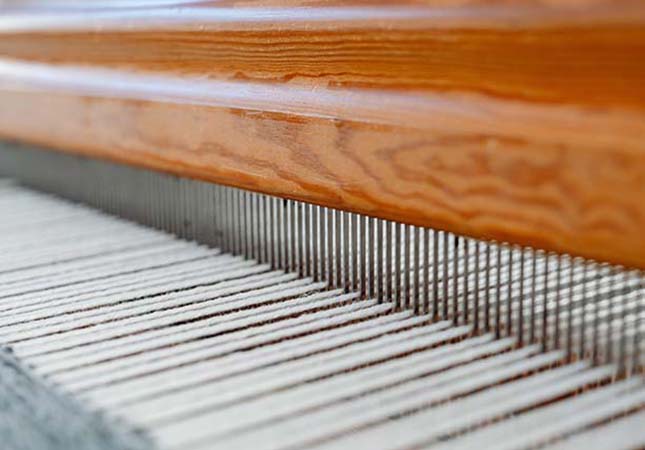The process of creating fabrics through weaving involves 2 fundamental motions known as warp and weft. These movements gave rise to the names of two essential components in weaving: the warp beam and the weaving beam. The warp beam, also referred to as a warp roller in American English, is situated at the back of the weaving loom. Its purpose is to hold the warp ends, which are the vertical threads, in preparation for the weaving process. On the other hand, the weaving beam, commonly known as the weaver's beam, is a sturdy and elongated wooden pole positioned at the top of the loom. Its function is to support the warp or vertical thread during the weaving process.

Macrostructure of Warp Beam
The warp beam's macrostructure comprises two primary components: the body and the head. The cylindrical body houses the warps, while the spherical head houses the weft. The weft is introduced into the warp through a hole in the head of the warp beam.
The warp beam is a critical structural element in weaving that provides support for the longitudinal threads, or warp, during the weaving process. It is typically mounted on the loom and can accommodate several threads wound around it.
Warping
In the production of terry fabric, the warping process holds significant importance as it minimizes the amount of additional material required for yarn sizing. The primary objective of the warping process is to maintain the uniform elongation of threads or yarns and ensure that they are consistently even. This involves combining yarns from multiple cones to create a continuous sheet of yarn.
Process of Warping
The process of warping is crucial for weaving as it lays the foundation for creating high-quality fabric. The weaver begins by determining the desired fabric width and the number of ends per inch required. They then calculate the required amount of thread for each end, accounting for take-up and shrinkage.
Next, the weaver ties the threads onto the warp beam and divides them into sections known as "sheds." The heddles are then passed through the sheds and attached to treadles that will raise and lower the warp threads during weaving. The weaver carefully adjusts the tension on the warp threads and secures them to the back of the loom before commencing the weaving process.
Without this critical step, it would be impossible to create a durable and consistent fabric width. Thus, the warping process plays a crucial role in producing high-quality woven textiles that are both functional and aesthetically pleasing.
2 Main Factors Affect The Fabric Quality
Slub Catcher & Tensioner Settings: The slub catcher is an electronic or mechanical device that identifies and removes neps or slubs in yarns. Electric versions of these devices are commonly available in the market. On the other hand, the tensioner setting is designed to achieve precise control of yarn tension and can be combined with an appropriate warping speed.
Uniform Warping Speed: Consistent warping speed is critical in producing high-quality woven fabric. The tensioner should apply less tension at higher warping speeds and more tension at lower warping speeds. The air drag facilitates balanced yarn tension, resulting in strong tension at elevated speeds and low tension at lower speeds.
Types of Warping Methods in Fabric Weaving
There are various types of warp beams and warping techniques utilized in fabric weaving. The most commonly used method is the cross warp, where the threads are intertwined in a criss-cross pattern. This technique is frequently used in the production of heavier fabrics, such as wool or denim.
Another popular method is the lengthwise warp, in which the threads are aligned parallel to one another. This type of warp is often employed for lighter fabrics like linen or cotton.
The balanced warp is yet another option, which involves interlacing two different sets of threads. This creates a sturdier and more durable fabric, making it a preferred choice for use in items such as rugs or upholstery.
SUNTECH possesses the capacity to personalize warp beam for all leading warper’s brands worldwide. The SUNTECH warp beam is appropriate for use with spun and filament yarn and is compatible with high-speed sectional and conventional warping machines such as Benninger, Karl Mayer, Hakoba, West Point, Suker, and others. SUNTECH warp beam is available in sizes ranging from 800mm flange diameter to 1400mm diameter, with a working width of 1600mm to 2800mm.
SUNTECH Textile Machinery is a distinguished manufacturer of textile machinery with a rich legacy of automation and intelligent manufacturing technology for textile and warehousing equipment. SUNTECH's state-of-the-art core technologies have garnered global recognition.
SUNTECH Textile Machinery has the range of products encompasses almost all fabric types, including but not limited to pinking machine, non-woven machine, beam truck, meltblown machine, fabric cutting machine, motorized beam trolley, beam storage, and fabric inspection machine. SUNTECH Textile Machinery continues to lead the textile industry with its innovative approach and extensive experience. We welcomes quotes and cooperation opportunities with open arms.




